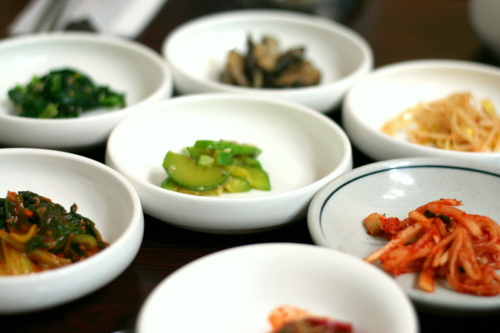Staying veggie in restaurants ― beware of hidden meat
By Korea HeraldPublished : May 22, 2012 - 19:09
This is the second in a series on how to get by as a vegan or vegetarian in rural Korea. ― Ed.
Vegetarian and without the time to prepare lunch or dinner? There are many tasty options that can be easily procured at typical Korean restaurants. Be sure to give each restaurant within reason at least one chance; the side dishes can make the difference between a tolerable snack and an enjoyable meal.
It will also help to know the popular Korean dishes that can be most easily vegan-ized. Most jjigae, or stew, is accessible. Sundubu Jjigae, which I’ve heard called “Korean comfort food,” typically comes with clam (jogye), shrimp (seu), egg (kyeran), and sometimes meat (gogi), but those can often be removed. In any case tofu will be a primary protein source so it’s a good dish to have, provided you can handle the mild spice.
Doenjang jjigae, a salty but not overpowering fermented soybean stew, often features clam ― and almost always a variety of seafood in coastal towns ― but you can get those taken out. Kimchi jjigae (kimchi stew) usually comes with meat and you can expect a fight to get it taken out, but with some patience you may get a meal.
Vegetarian and without the time to prepare lunch or dinner? There are many tasty options that can be easily procured at typical Korean restaurants. Be sure to give each restaurant within reason at least one chance; the side dishes can make the difference between a tolerable snack and an enjoyable meal.
It will also help to know the popular Korean dishes that can be most easily vegan-ized. Most jjigae, or stew, is accessible. Sundubu Jjigae, which I’ve heard called “Korean comfort food,” typically comes with clam (jogye), shrimp (seu), egg (kyeran), and sometimes meat (gogi), but those can often be removed. In any case tofu will be a primary protein source so it’s a good dish to have, provided you can handle the mild spice.
Doenjang jjigae, a salty but not overpowering fermented soybean stew, often features clam ― and almost always a variety of seafood in coastal towns ― but you can get those taken out. Kimchi jjigae (kimchi stew) usually comes with meat and you can expect a fight to get it taken out, but with some patience you may get a meal.

Noodle dishes are also very vegetarian-friendly provided you can ignore that trace amounts of meat fat go into the noodles. If you can’t you will need to buy special “cheshik” ramen at organic stores, if you can find it. Jjolmyeon, chewy ramen, is usually vegetarian but with a hard-boiled egg on top, and served with a decent handful of vegetables. Most ramen comes free of meat, only meat flavoring, and most udong comes with only a few fish cakes.
Other noodle dishes like naengmyeon (cold noodles) or makgugksu (wheat noodles) are typically void of meat and fish, and again feature the easily removable hard-boiled egg. Summer is a fine time to enjoy the mul (water or “in soup”) variety of both; the broth is a subtle concoction of many things, including pear juice and vinegar, and if you want more kick you can add the mustard that is on your table.
Tteokbokki always uses some fish in the base paste, but if you don’t mind that just say “odaeng ppego juseyo” to get the fish cake chunks taken out.
Ironically, bibimbap is one of the least vegetarian-friendly dishes. “Mixed rice?” No ― mixed rice with a bunch of bits of meat and pieces of egg. The hot version served in a scorching earthenware bowl, dolsot bibimbap, is even worse ― the egg is typically broken into the dish raw, spreading all over everything. “Gogi wa kyeran ppego juseyo” (take out the meat and egg, please) is your friendly phrase here.
Particularly avoid the famous jeonju bibimbap ― the rice is cooked with cow bone marrow to make the famous texture. However if you do get it prepared correctly, bibimbap is a nice balanced meal, particularly if you get the “dolsot bibimbap.”
Furthermore, dumplings are not on the vegetarian’s side. “Kimchi” or “vegetable” mandu will always have trace amounts of meat, and generally the salesperson will tell you that there is no meat in them. They are pre-made and can’t be altered. To date I have found two stores (one in Seoul and one in Busan) selling actual vegetarian mandu, and sometimes seen frozen vegetarian mandu in organic (“yuginong”) grocers. The last time I ate pork was after biting into a dumpling that I had been assured was “meat-free.”
Finally, we have to talk about kimchi. Outside temples it is almost never vegetarian. Some fish or seafood is usually used (though not needed) as a fermentation agent. Unless you’re living in a temple, making it yourself, or allergic, it’s best to accept that tiny bit of seafood. If you haven’t realized by now, trust me, you need the fiber.
On that rather appetizing note we finish this column. Next time we’ll discuss how to get the ingredients you need from street markets (with some exceptions) so as to expand the culinary horizons, and after that we’ll get to cooking.
By Darren Bean!
Darren Bean! is a former prosecutor and lecturer in the department of Criminology at Chosun University. He can be reached at themagicbean@hotmail.com. The exclamation point is part of his legal name. ― Ed.
-
Articles by Korea Herald



















